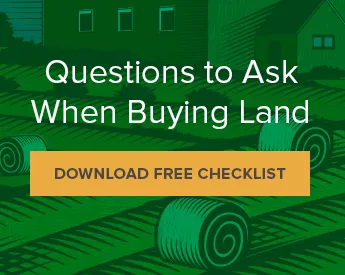Cover Crops For Gardens: A Beginner's Guide [Part 2]
![Cover Crops For Gardens: A Beginner's Guide [Part 2]](https://rethinkrural.raydientrural.com/hs-fs/hubfs/GettyImages-2211476037.jpg?length=1151&name=GettyImages-2211476037.jpg)
In the second article of this 2-part series, you’ll learn about the best tools for cover cropping your garden, along with simple termination tips and techniques.
In Part 1 of this article, we covered what cover crops are, how they work to improve soil health, the best types of cover crops for beginners, and how to choose one for your garden, where to find seeds and basic planting tips.
Part 2 is all about the three Ts: tools, termination and techniques.
Farming and gardening are hard work, and having the right tools is not just a luxury; it’s a necessity.
Here’s what you’ll need to help make your garden cover cropping experience much more efficient and enjoyable.
Seeder
A seeding tool isn’t a must for cover crops because you can always broadcast by hand.
However, the benefits of using a seeding tool are:
- Better germination rates because you ensure better seed to soil contact
- More precision with planting depth and row space
- And less wasted seed
A seeder can also be used for other crops that are directly seeded in your veggie garden.
There are a variety of seeders to choose from, ranging in price. My preferred seeder is the Earthway Seeder.
I like this one because it is affordable, lightweight and it comes with seven seed plates, giving you many options for different seed sizes and optimal spacing.
If you go with this tool, here is a list of the seed plates I use to seed the cover crop recommendations made in Part 1:
- Oats, Rye (Any grass seed): Beet plate
- Field Peas & Oil Seed Radish: Small Pea Plate
- Clovers & Vetches: Lettuce/Carrots/Fine Seed Plate

The last thing to figure out with your seeder is how far apart to space the seed.
You can space out each lane within the growing bed 4 to 5 inches apart.
I have standardized my growing beds to 30 inches and seed 6 to 7 rows alternating cover crop seed with each row. If you have larger beds, keep to the 4 to 5 inches to start, and make your own observations and adjustments from there.
If you don’t think you are getting good canopy coverage, seed more densely next time. If things are too crowded, decrease the amount of seed in your rows.
The most important thing is not to leave any soil exposed.
Silage Tarp
A silage tarp is very handy, and I would say, necessary for cover crops.
Why are they important? They help ensure you completely terminate the cover crop so it doesn’t continue to grow.
Once you terminate the cover crops, the silage tarp smothers the cover crop, preserving moisture and starving the plants from sunlight, preventing any chance of having it regrow.
On a large scale, this is not economical, but on a home garden or market garden scale, this can save you tons of headaches. We will get into the steps of using a tarp later, but here are the tarp specifications to look for.
Use a black silage tarp that is UV-resistant and at least 6 mils thick. You can buy them in various sizes, but if you need a small size, you can always cut them to the length of your beds and garden layout.
Here is a source I have used in the past, but these tarps can also be found at your big box or local hardware stores.
A solid silage tarp isn’t cheap, but if you get the right one and take care of it, it can last for years.

Tillage Tools
Choosing your favorite tillage tool will enhance the growth and root penetration of your cover crops.
Some form of minimal tillage (not too much) breaks up the soil, allowing better aeration for better root growth.
Growing bigger, more robust roots is the goal with cover crops because you have more exudate production to build microbe populations aggressively, and when it's terminated, all those roots will decompose in place and build large amounts of organic matter.
The best way I’ve found to aerate my soil is using a broadfork or a sturdy digging fork. See this article on Must Have Tools and Accessories for Gardeners for more details.
As for mechanical tillage tools like a rototiller, I would use these sparingly.
Excessive tillage year in year out is detrimental to soil health as it begins to destroy soil structure, followed by a decline in beneficial soil microbes, among other things.
Tillage isn’t the best for soil health, but when done thoughtfully and periodically, it can be very helpful in a larger context with the goal of improving soil health.
For example, one of the best times to till is to break new ground that has been in sod, turf or pasture. You can use a tarp to do this, too, but it takes more time and planning to do it well.
How To Terminate Your Cover Crop
Proper termination will make or break your success with cover crops.
There is nothing worse than not killing the cover crop completely and having it turn into a weed for the remainder of the growing season, if not longer.
The best time to terminate is when the cover crop is in the milk stage, when the seed head is green. This is when the crop is at its largest, having the most biomass for mulch, and it makes it easiest to kill.
There are two basic steps to cover crop termination:
- Knock it down
- Smother it
Tools For Terminating Your Cover Crop
The first way to knock it down is by crimping. I haven’t incorporated this technique, but many farmers like Daniel Mays of Firth Farm have done it with success.Homemade Crimper
In crimping, you use a homemade tool to push the crop down and “snap” the stems.
You can make a crimping tool by using a long board or T-post with a string or rope attached to the ends to hold onto.
Then you start at one end of your crop (ideally, with two people) and move the board/t-post along and step on the tool at the base of the cover crop, thus “crimping” it.
Weed Whacking
My method has been to use a weed whacker with a brush cutter blade. On my small-scale farm, this works great and doesn’t consume too much fuel.
If you are working on a larger scale, the method implemented by farmer Daniel Mays will be more efficient.

Mowing
The last way to do this is also to mow it down.
Really, the only way to do this effectively is with a flail mower or a more robust mower or bush hog.
Cover crops like oats and rye grow large and thick, which is beyond the capabilities of a push mower.
Related reading: Must Have Tools, Toys and Tractors for Rural Acreage
After Termination, It's Time To Tarp
After the cover crop’s been knocked down, the next step is to pull over the tarp.
In my opinion, you mustn’t skip this step! Tarping gives you 100% assurance that the crop is completely killed, never to return and become a weedy problem.
How Long To Tarp?
In the hottest months of summer, 2 weeks should be fine. In the cooler months of late winter or early spring, 2 to 6 weeks. If the crop winter kills, obviously, no tarp is needed.
Planting Your Cover Crop After Terminating
Once the cover crop is terminated completely, there are a couple of ways you can start your planting.
If there is no need for soil amendments or irrigation, such as drip tape, then you can plant straight into the ground through the above-ground biomass/leftover dead cover crop.
This above-ground biomass will provide a mulch layer that will eventually decompose throughout the growing season, providing a steady feed for beneficial soil microbes.
As with any mulch, it helps preserve soil moisture and provides that protective layer to maintain overall soil integrity.
If you like to add soil amendments, like me, here’s another way to plant.
- Pull away the tarp
- Rake above-ground biomass into the rows
- Fork the beds to aerate them, introducing oxygen to accelerate decomposition of the terminated roots of the previous cover crops
- Apply compost or your preferred soil amendments
- Direct seed or transplant plant starts

Final Thoughts On Cover Cropping for Gardens
Following these guidelines will help you get started on a path to success with cover crops for your garden.
I believe that to really understand something, you have to live and experience it.
Articles like this, books, courses and YouTube videos help, but to know something well, you need actually to do it, so get out there and give it a go! Fall is a perfect time to start and take advantage of winterkill crops.
As promised, here is a list of recommended reading on cover crops and soil health:
- Living Soils Handbook by Jesse Frost
- The No-Till Organic Vegetable Farm by Daniel Mays
- The Complete Guide to Restoring Your Soil by Dale Strickler
Looking for more articles like this? Check out the following:
- Cover Crops For Gardens: A Beginner's Guide [Part 1]
- How To Start Seeds: Comparing 3 Low-Waste Seed Starting Methods
- Must-Have Tools and Accessories for Gardeners
References:
https://crops.extension.iastate.edu/encyclopedia/frequent-tillage-and-its-impact-soil-quality





-1.jpg?width=100&height=100&name=Rolando%20Boye%20Head%20Shot%20(002)-1.jpg)





Your email address will not be published. Required fields are marked*